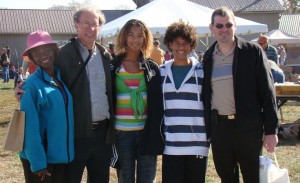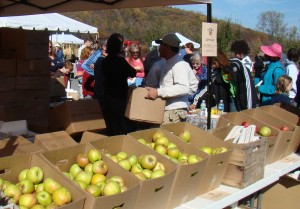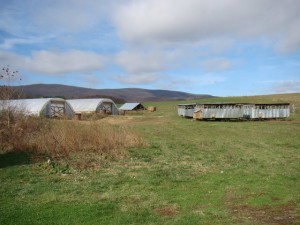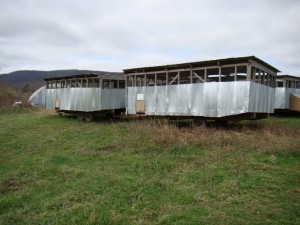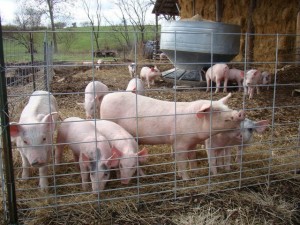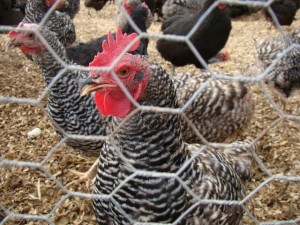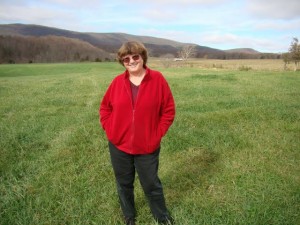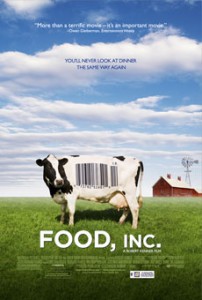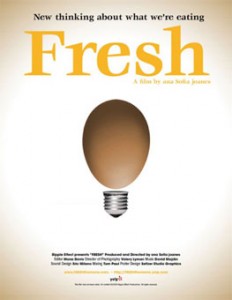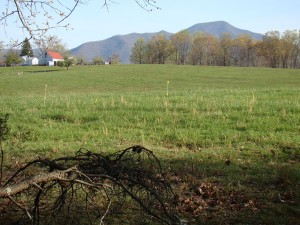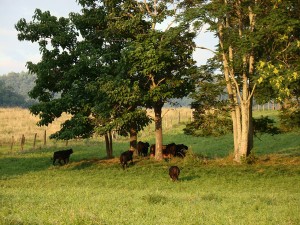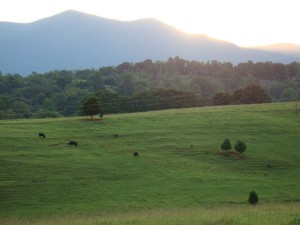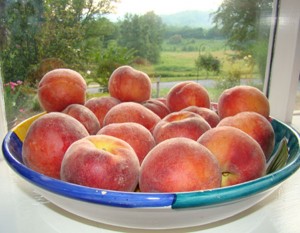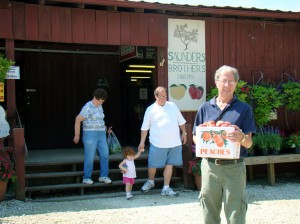Fri 11 Dec 2009
A Fruitful Gift
Posted by Bob under Family and Friends, Farms and Food, Our New Home
[2] Comments
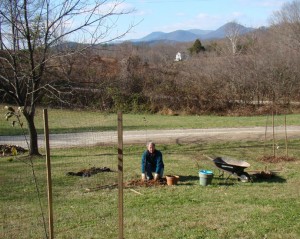 At my Rutgers retirement party last spring, my colleagues gave me a generous and thoughtful gift: a gift certificate for fruit trees from Vintage Virginia Apples, an orchard and tree nursery about twenty minutes away, which is trying to keep alive varieties of apples and other fruit no longer commercially available. We had to wait until the trees were dormant, but on Tuesday we picked up five two-year old trees, and the past two days have been spent planting them and protecting them with deer netting. (You may click on the picture of me planting the Grimes Golden for a larger view.)
At my Rutgers retirement party last spring, my colleagues gave me a generous and thoughtful gift: a gift certificate for fruit trees from Vintage Virginia Apples, an orchard and tree nursery about twenty minutes away, which is trying to keep alive varieties of apples and other fruit no longer commercially available. We had to wait until the trees were dormant, but on Tuesday we picked up five two-year old trees, and the past two days have been spent planting them and protecting them with deer netting. (You may click on the picture of me planting the Grimes Golden for a larger view.)
We bought and planted five trees, as follows (descriptions are from VVA’s catalog):
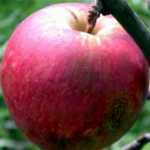 VIRGINIA BEAUTY originated on the property of Zach Safewright in the Piper Gap area of Carroll County, Virginia. In the 1850s, it was given the name Virginia Beauty. Large in size and oblate to truncate in shape, the smooth and glossy, greenish-yellow skin is half to nearly totally covered a shaded brick-red with indistinct red stripes in the greener areas… The yellow flesh is fine-grained, tender, and a light sweetness in flavor… In the early part of the 20th century, the Virginia Beauty was popular for not only dessert, but also for processing, especially for apple preserves. It stores very well and ripens the first weeks of October.
VIRGINIA BEAUTY originated on the property of Zach Safewright in the Piper Gap area of Carroll County, Virginia. In the 1850s, it was given the name Virginia Beauty. Large in size and oblate to truncate in shape, the smooth and glossy, greenish-yellow skin is half to nearly totally covered a shaded brick-red with indistinct red stripes in the greener areas… The yellow flesh is fine-grained, tender, and a light sweetness in flavor… In the early part of the 20th century, the Virginia Beauty was popular for not only dessert, but also for processing, especially for apple preserves. It stores very well and ripens the first weeks of October.
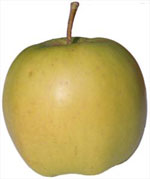 GRIMES GOLDEN was found by Thomas Grimes in Brooke County, West Virginia, 1804, near Wellsburg, West Virginia, where John Chapman, known as Johnny Appleseed, established a nursery with his brother. One of the parents of Golden Delicious. Roundish or slightly oblong in form, small to medium in size, with a greenish-yellow skin, ripening to a clear yellow.. Yellowish flesh is crisp and tender, with a spicy, sweet flavor. A good all-purpose apple, it contains 18.81% sugar that ferments to a 9% alcohol, popular for making hard cider… Self-fertile and an excellent pollinator for other varieties… Ripens in late September and stores very well.
GRIMES GOLDEN was found by Thomas Grimes in Brooke County, West Virginia, 1804, near Wellsburg, West Virginia, where John Chapman, known as Johnny Appleseed, established a nursery with his brother. One of the parents of Golden Delicious. Roundish or slightly oblong in form, small to medium in size, with a greenish-yellow skin, ripening to a clear yellow.. Yellowish flesh is crisp and tender, with a spicy, sweet flavor. A good all-purpose apple, it contains 18.81% sugar that ferments to a 9% alcohol, popular for making hard cider… Self-fertile and an excellent pollinator for other varieties… Ripens in late September and stores very well.
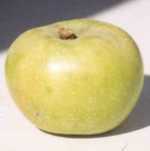 REINETTE SIMIRENKO may be the same as Wood’s Greening. There is some uncertainty whether it originated as claimed in the garden of P. F. Simirenko in the Ukraine, or in the United States, as Wood’s Greening. It was described in 1895, and was popularized by Soviet cosmonauts, who took the apple into space for dessert. Medium in size, the greenish-yellow skin has a brownish-orange flush, and is russeted in the cavity and dotted on the surface. The finish is waxy. The greenish-white flesh is tender and crisp with a subacid flavor. It bears early and heavily and will also hang long on the tree after ripening. The tree top develops into a wide pyramidal crown and the variety is very drought resistant. It stores well and ripens in October. [Note: it appears that Wood’s Greening came first, and was developed by a family named Wood (no relation as far as I know, but who knows?) in Burlington County, New Jersey in the early 19th century.]
REINETTE SIMIRENKO may be the same as Wood’s Greening. There is some uncertainty whether it originated as claimed in the garden of P. F. Simirenko in the Ukraine, or in the United States, as Wood’s Greening. It was described in 1895, and was popularized by Soviet cosmonauts, who took the apple into space for dessert. Medium in size, the greenish-yellow skin has a brownish-orange flush, and is russeted in the cavity and dotted on the surface. The finish is waxy. The greenish-white flesh is tender and crisp with a subacid flavor. It bears early and heavily and will also hang long on the tree after ripening. The tree top develops into a wide pyramidal crown and the variety is very drought resistant. It stores well and ripens in October. [Note: it appears that Wood’s Greening came first, and was developed by a family named Wood (no relation as far as I know, but who knows?) in Burlington County, New Jersey in the early 19th century.]
We also planted two Black Heart Cherry trees, for which rather little information is available: “BLACK HEART Cherries are a sweet dark fruit on a large tree. Fruit matures early and over a relatively long season.” Our understanding is that they have been grafted from a tree on an old farm in this area.
It will take a little patience, but we’re excited about tasting and sharing these fruits in the future. And heartfelt thanks to my (still-working stiff) colleagues back at Rutgers for this wonderful gift!
Pictures from the Vintage Virginia Apples Harvest Festival
